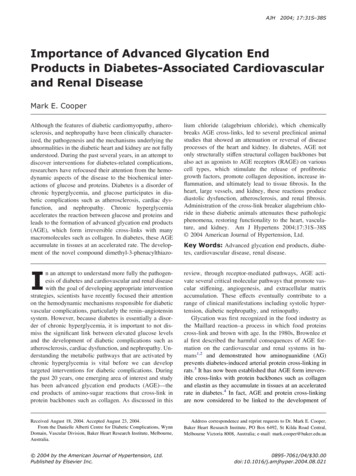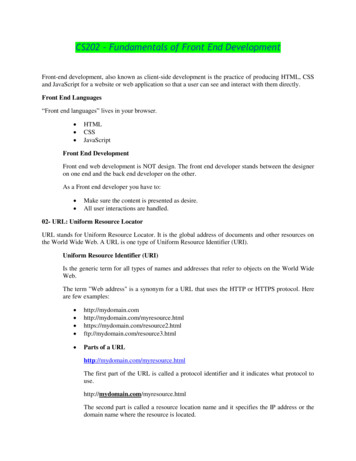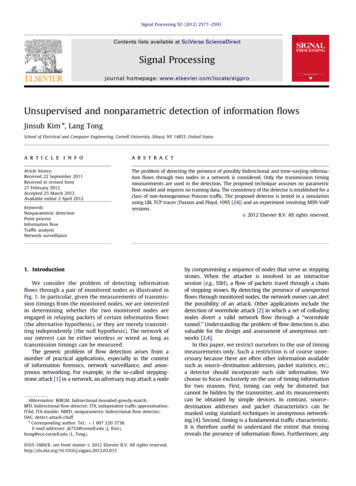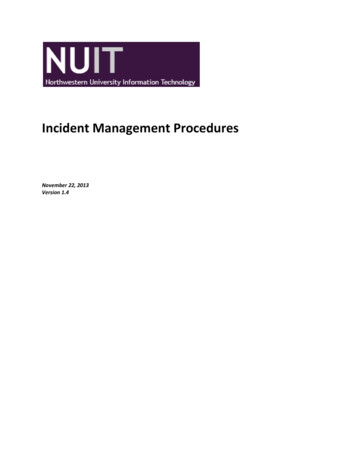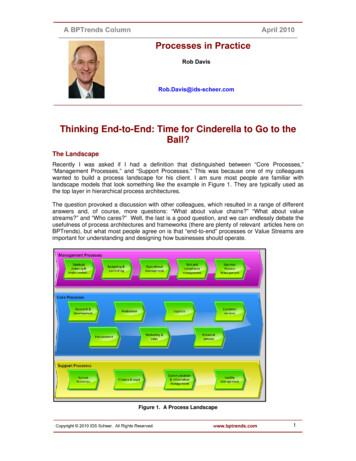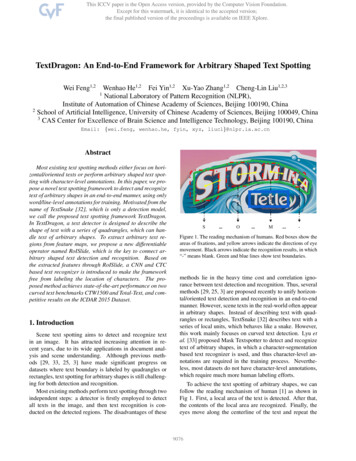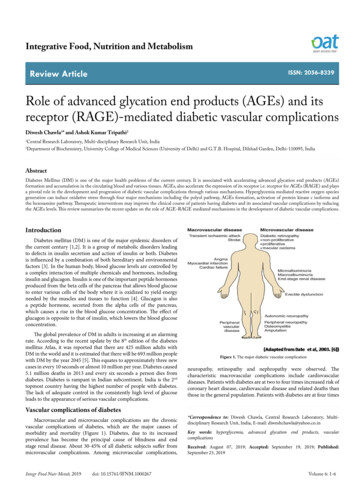
Transcription
Integrative Food, Nutrition and MetabolismReview ArticleISSN: 2056-8339Role of advanced glycation end products (AGEs) and itsreceptor (RAGE)-mediated diabetic vascular complicationsDiwesh Chawla1* and Ashok Kumar Tripathi2Central Research Laboratory, Multi-disciplinary Research Unit, IndiaDepartment of Biochemistry, University College of Medical Sciences (University of Delhi) and G.T.B. Hospital, Dilshad Garden, Delhi-110095, India12AbstractDiabetes Mellitus (DM) is one of the major health problems of the current century. It is associated with accelerating advanced glycation end products (AGEs)formation and accumulation in the circulating blood and various tissues. AGEs, also accelerate the expression of its receptor i.e. receptor for AGEs (RAGE) and playsa pivotal role in the development and progression of diabetic vascular complications through various mechanisms. Hyperglycemia mediated reactive oxygen speciesgeneration can induce oxidative stress through four major mechanisms including the polyol pathway, AGEs formation, activation of protein kinase c isoforms andthe hexosamine pathway. Therapeutic interventions may improve the clinical course of patients having diabetes and its associated vascular complications by reducingthe AGEs levels. This review summarizes the recent update on the role of AGE-RAGE mediated mechanisms in the development of diabetic vascular complications.IntroductionDiabetes mellitus (DM) is one of the major epidemic disorders ofthe current century [1,2]. It is a group of metabolic disorders leadingto defects in insulin secretion and action of insulin or both. Diabetesis influenced by a combination of both hereditary and environmentalfactors [3]. In the human body, blood glucose levels are controlled bya complex interaction of multiple chemicals and hormones, includinginsulin and glucagon. Insulin is one of the important peptide hormonesproduced from the beta cells of the pancreas that allows blood glucoseto enter various cells of the body where it is oxidized to yield energyneeded by the muscles and tissues to function [4]. Glucagon is alsoa peptide hormone, secreted from the alpha cells of the pancreas,which causes a rise in the blood glucose concentration. The effect ofglucagon is opposite to that of insulin, which lowers the blood glucoseconcentration.The global prevalence of DM in adults is increasing at an alarmingrate. According to the recent update by the 8th edition of the diabetesmellitus Atlas, it was reported that there are 425 million adults withDM in the world and it is estimated that there will be 693 million peoplewith DM by the year 2045 [5]. This equates to approximately three newcases in every 10 seconds or almost 10 million per year. Diabetes caused5.1 million deaths in 2013 and every six seconds a person dies fromdiabetes. Diabetes is rampant in Indian subcontinent. India is the 2ndtopmost country having the highest number of people with diabetes.The lack of adequate control in the consistently high level of glucoseleads to the appearance of serious vascular complications.Vascular complications of diabetesMacrovascular and microvascular complications are the chronicvascular complications of diabetes, which are the major causes ofmorbidity and mortality (Figure 1). Diabetes, due to its increasedprevalence has become the principal cause of blindness and endstage renal disease. About 30-45% of all diabetic subjects suffer frommicrovascular complications. Among microvascular complications,Integr Food Nutr Metab, 2019doi: 10.15761/IFNM.1000267Figure 1. The major diabetic vascular complicationneuropathy, retinopathy and nephropathy were observed. Thecharacteristic macrovascular complications include cardiovasculardiseases. Patients with diabetes are at two to four times increased risk ofcoronary heart disease, cardiovascular disease and related deaths thanthose in the general population. Patients with diabetes are at four times*Correspondence to: Diwesh Chawla, Central Research Laboratory, Multidisciplinary Research Unit, India, E-mail: diweshchawla@yahoo.co.inKey words: hyperglycemia, advanced glycation end products, vascularcomplicationsReceived: August 07, 2019; Accepted: September 19, 2019; Published:September 23, 2019Volume 6: 1-6
Chawla D (2019) Role of advanced glycation end products (AGEs) and its receptor (RAGE)-mediated diabetic vascular complicationshigher risk of developing peripheral vascular disease (PVD) [6] Each ofthese organ specific vascular complications has its own unique, clinicaland histologic features, but all are common with increasing durationof hyperglycemia and are driven by its downstream cellular signalingpathways [7].The Diabetes Control and Complications Trial (DCCT) andUnited Kingdom Prospective Diabetes Study Trial (UKPDS) haveclearly demonstrated the vital importance of intensive glycemiccontrol in preventing the progression of diabetic complications [8,9].Hyperglycemia inflicts cumulative long-term structural and functionalchanges in important macromolecules through advanced glycationend products (AGEs). Hyperglycemia induces a variety of metabolicchanges, which includes activation of polyol pathway, activation of thediacylglycerol-protein kinase c, and increased oxidative stress. In thisreview, we summarize the recent updates on AGEs and the role of AGERAGE interaction-mediated various pathways which lead to diabeticvascular complications.Hyperglycemia mediated ROS generationOxidative stress (OS) is defined as an imbalance between thereactive oxygen species (ROS) generation and the body’s antioxidantdefense system [10-12]. Various studies have evidenced that OS plays animportant role in the pathogenesis of a wide range of human disorderssuch as diabetes, cancer, cardiovascular disorders, kidney diseasesand neurodegenerative diseases [13-16]. Also the most importantpathogenic role of OS in the initiation and development of diabetesassociated complications has been determined. Free radical generationin hyperglycemic conditions may lead to OS in β-cells of the pancreas,which causes β-cell dysfunction and other long term complications ofdiabetes because of insulin secretion and /or its function impairment[17-20].Under the normal physiological conditions, ROS generationmay help in cell defense, hormone synthesis, signal transduction,transcription factor regulation and gene expression. While underpathological conditions; inflammation, tissue damage, fibrosis andβ-cell death may occur [21,22]. There are four major mechanismsinvolved in the increased intracellular OS as a result of hyperglycemia,which includes the polyol pathway, advanced glycation end productformation, protein kinase c–diacyl glycerol pathway and hexosaminepathway (Figure 2). It has been reported that all of these pathwaysare activated by mitochondrial ROS overproduction. The effects ofROS generation can be modified by enzymatic or non-enzymaticantioxidants. Enzymatic antioxidant includes catalase, superoxidedismutase, nitric oxide synthase, glutathione peroxidase, glutathiones-transferase and nicotinamide adenine dinucleotide phosphate(NADPH) oxidase. Non- enzymatic antioxidant includes vitamins,minerals, polyphenols, carotenoids and some other molecules [23,24].The polyol pathway mainly focuses on the enzyme aldosereductase. Normally aldose reductase reduces toxic aldehydes inthe cells to inactive alcohols, but under hyperglycemic condition,it utilizes NADPH and converts excessive intracellular glucose intothe forms of sugar alcohols [15]. In healthier individuals, this pathwayutilizes a very small fraction of the total glucose while in diabeticpatients aldose reductase activated and induces increased conversion ofglucose to sorbitol. After then, sorbitol is oxidized to fructose by enzymesorbitol dehydrogenase with NAD as a cofactor [18]. Consumption ofNADPH reduces glutathione reductase (GSH) activity as GSH is wellknown important scavenger of ROS [18,20,21]. Finally the processinduces ROS generation and exacerbates intracellular OS.Integr Food Nutr Metab, 2019doi: 10.15761/IFNM.1000267Figure 2. Hyperglycemia-mediated pathwaysHyperglycemia also induces overproduction of both theintracellular and extracellular AGEs [1]. Advanced glycationend product formation occurs as the result of glyoxal oxidation,3-deoxyglucosome formation and fragmentation of glyceraldehyde3-phosphate into methyl glyoxal [15]. Cellular damage may occurdue to intracellular production of AGE precursors through mainlythree general mechanisms. Firstly, the functional intracellularproteins modification by AGEs may occur. After then abnormalinteraction of extracellular matrix compounds which were modifiedby AGEs precursors with other matrix components and receptorssuch as integrin is observed. At last, finally the plasma proteins aremodified by AGEs precursors binding to cell surface receptors such asreceptor for AGEs (RAGE) or macrophage scavenger receptor [18,21].This AGE-RAGE interaction may contribute to OS via induction ofmitochondrial superoxide and cytosolic NADPH oxidase dependentmechanism, which activates multiple signals such as p21RAS, NFkB, MAP kinase, TGF-β, vascular adhesion molecules, etc. Thistranscribes the number of pro-inflammatory genes and subsequentlyelicits vascular inflammation, over expression of endothelial growthfactor, impaired fibrinolytic affinity, platelet aggregation, angiogenesisand thrombosis, thereby playing a central role in the pathogenesis ofvascular complications in diabetes by enhancing the OS development[25-28]. These observations suggest that in diabetes, the increasedAGEs production might alter glucose metabolism through direct attackon pancreatic insulin producing cells.Protein kinase C (PKC) consists of at least eleven isoformsin mammalian tissues. Increased activation of PKC isoforms isthe third most important pathway which induces tissue injurythrough hyperglycemia mediated ROS. Increased ROS generationinhibits activity of glycolytic enzyme glyceraldehydes-3-phosphatedehydrogenase, which leads to increase the level of diacyl glycerol(DAG) precursors [15]. Tissue phosphate also enhances the de novosynthesis of DAG from glucose. AGE- RAGE interaction also increasesthe activity of PKC isoforms. Hyperglycemia induced PKC activationmay lead to over expression of plasminogen activator inhibitor-1 (PAI1) and activation of NF-kB [22]. This may lead to vascular damagevia inflammation; increase the permeability of basement membranethickening, angiogenesis and thrombotic vascular occlusion.Under hyperglycemic condition, when the glucose level is higherinside the cell, most of the glucose is metabolized through glycolysisto glucose-6-phosphate, then to fructose-6-phosphate. Increasing theflux of fructose-6-phosphate into the hexosamine pathway may alsoVolume 6: 2-6
Chawla D (2019) Role of advanced glycation end products (AGEs) and its receptor (RAGE)-mediated diabetic vascular complicationscontribute to pathogenesis of diabetic vascular complications [15].Fructose-6-phosphate is diverted from glycolysis to provide glutaminefructose-6-phosphate aminotransferase (GFAT). After the conversionof fructose-6- phosphate to glucosamine-6-phosphate by GFAT, it isconverted into UDP-N-acetyl glucosamine. It has been shown thathyperglycemia causes four folds increase in UDP-NAG, which induceshyperglycemia mediated activation of the PAI-1 and TGF-β1 [19,21].Under normal conditions, very small amount of glucose is metabolizedthrough this pathway.Therefore, it was believed that under hyperglycemic condition,mitochondria derived, OS leads to AGEs formation, DAG synthesisaccelerated, PKC activation, sorbitol or fructose accumulation inthe cells as a result of polyol pathway activation. These hypothesessuggest that hyperglycemia mediated OS play an important role in thepathogenesis of vascular disorders.Biochemistry of advanced glycation end productsHyperglycemia accelerates non-enzymatic reaction between thefree amino groups of proteins and carbonyl groups of reducing sugarsor other carbonyl compounds leading to enhanced formation of AGEs,also known as the Maillard reaction [25,26]. Advanced glycationend product formation is a complicated molecular process involvingmultistep reaction. A reducing sugar, such as glucose reacts nonenzymatically with the free amino group of protein to form an unstablecompound, the Schiff base which undergoes a rearrangement reactionto form a more stable product known as Amadori product [27,28]. TheAmadori adducts then very slowly undergo irreversible dehydrationand condensation reactions leads to the formation of AGEs, which isyellowish brown material with the particular fluorescence. Advancedglycation end products are not produced only from glucose, but alsofrom dicarbonyl compounds produced from auto-oxidation and thedegradation products of glucose such as glyoxal, methylglyoxal and3-deoxyglucosone or α-hydroxy aldehydes such as glyceraldehydes andglycoaldehyde. In addition, AGEs can also act as cross-linkers betweenproteins, resulting in the production of proteins-resistant aggregates[29].Under chronic hyperglycemic condition, AGEs are activelyproduced and accumulate in the circulating blood and various tissues,resulting in vascular complications in diabetes. Furthermore, humansare also exposed to exogenous AGEs including tobacco, smoke, and diet.Food processing methods, such as prolonged heating and microwavecooking, can also accelerate the AGEs formation. As discussed earlier,the AGEs formation reaction also referred as browning reaction, thisbrown color change of food can be a measure of their AGE content. Overa dozen AGEs have been detected in tissues and can be divided into threecategories: 1. Fluorescent cross-linking AGEs such as pentosidine andcrossline. 2. Non-fluorescent cross-linking AGEs such as imidazoliumdilysine cross-links, alkyl formyl glycosyl pyrrole (AFGP) cross-linksand arginine-lysine imidazole (ALI) cross-links. 3. Non-cross- linkingAGEs such as pyrraline and N-carboxymethyllysine (CML) [30]. Theserum AGEs level was determined spectrofluorometrically at emissionmaximum (440 nm) upon excitation at 350 nm [26]. Briefly, serumwas diluted 1:50 with phosphate buffer saline (PBS) (pH 7.4) andfluorescence intensity was expressed in arbitrary units (AU). Totalserum AGEs were also determined by ELISA using commercial kits.Previously, we have reported that higher levels of circulating AGEswere observed in diabetic patients having vascular complicationsindicating that higher the serum AGEs level, higher the likelihoodof development of vascular complication of diabetes [31-33]. EarlierIntegr Food Nutr Metab, 2019doi: 10.15761/IFNM.1000267gradual increase in serum AGEs-level have been reported with theseverity of atherosclerosis in diabetic patients [34,35]. Kalusova et aldetermined AGEs spectrofluorometrically and found AGEs were about23% higher in diabetic patients compared to healthy individuals [36].In recent studies, AGEs level has been suggested to act as a predictor ofCVD mortality and diabetic nephropathy [37-41].Recent studies have evidenced that AGEs may be a key factor in thedevelopment of metabolic memory in diabetic vascular complications,because AGEs are produced and accumulated irreversibly in the body,depending on the degree of blood sugar regulation and duration[42,43]. AGEs interact with two main types of cell surface receptors viz,scavenger receptors, which remove and degrade AGEs and the one isreceptor for AGEs (RAGE), which triggers specific cellular signalingresponses on AGE binding.AGE-RAGE interaction-mediated pathwaysRAGE is one of the best characterized receptor which is responsiblefor AGEs related diabetic vascular complications, leads to activatingthe stress response leading to inflammation and cellular dysfunction[44-46]. RAGE is a 45kD transmembrane receptor of immunoglobinsuperfamily composed of 404 amino acid. It binds to many ligandsapart from AGEs, such as high mobility group proteins B1, S100calcium binding proteins including calgranulin, amyloid β proteinand amphotericin [47-51]. Apart from the full length, RAGE alsoavailable as soluble circulating isoform including sRAGE1/2/3,esRAGE (endogeneous soluble RAGE) and hRAGEsec (human RAGEsecreted). A number of mechanisms have been reported that lead tothe production of soluble proteins, alternative splicing of the mRNAto remove the transmembrane domain and the proteolytical cleavagefrom the cell surface. Various studies of RAGE have shown that sRAGEcan be formed by both alternative splicing and proteolytic cleavage[52-54]. AGE-RAGE interaction activates signals through TGF-β, NFkB, MAP kinase and NADPH oxidases, which induces the expressionof E-selectin, vascular adhesion molecule-1, VEGF and variouspro- inflammatory cytokines such as IL-1β, IL-6 and TNF-α (Figure3). Under hyperglycemic conditions, activation of these signalingpathways is increased in vascular smooth muscle cells, leads to vascularfibrosis, calcification inflammation, prothrombotic effects and vasculardamage processes like diabetic nephropathy, neuropathy, retinopathyand cardiovascular diseases. AGE-RAGE interaction mediated OS notonly responsible for vascular disorders by activating renin angiotensinsystem (RAS) but also aggravate organ dysfunction, because RASactivation causes NADPH oxidase-mediated OS that may enhanceRAGE expression and AGEs formation. In endothelial cells, AGERAGE interaction exacerbates the expression of p22phox and gp91phox,which are the main components of NADPH oxidase, which promotesthe production of ROS by activating the cell membrane transport ofRac family small GTPase1 (Rac1) to cause endothelial cell dysfunction[55-57]. Therefore, targeting the AGE-RAGE interaction has beenconsidered as a potential therapeutic strategy to prevent or reducevascular complications in diabetes.Therapeutic intervention of AGEsInhibition of AGEs formation and attenuating the AGE-mediatedeffects may be considered as ideal candidates for pharmaceuticalintervention in the amelioration of diabetic vascular complications.Therapies against the AGEs mediated effect can through diversepathways, like inhibiting the production of Amadori products,decreasing AGE-RAGE interaction, detoxifying dicarbonylintermediates and interrupting biochemical pathways that impact onVolume 6: 3-6
Chawla D (2019) Role of advanced glycation end products (AGEs) and its receptor (RAGE)-mediated diabetic vascular complicationsmay be an approachable target of delaying or preventing the onset ofdiabetic complications. Various compounds are under investigationfor their possible therapeutic intervention. Finally, the use of AGEsas biomarkers/predictors of diabetic complications may be helpful toreduce health problems in diabetic patients.References1. Gray SP, Jandeleit-Dahm K (2014) The pathobiology of diabetic vascular complicationscardiovascular and kidney disease. JMM 92: 441-452.2. Banerjee M, Vats P (2014) Reactive metabolites and antioxidant gene polymorphismsin Type 2 diabetes mellitus. Redox Biology 2: 170-177.3. Góth L, Nagy T (2012) Acatalasemia and diabetes mellitus. Arch Biochem Biophys 525:195-200. [Crossref]4. Harris M, Zimmet P (1997) Classification of diabetes mellitus and other categories ofglucose intolerance. Alberti K, Zimmet P, Defronzo R, editors. International textbookof diabetes mellitus. Second Edition. Chichester: John Wiley and Sons Ltd, pp9: -23.5. International diabetes federation (2017) IDF Diabetes Atlas, 8th edn. Brussels,Belgium: International diabetes federation, 2017. http://www.diabetesatlas.org.6. Bate KL, Jerums G (2003) 3: Preventing complications of diabetes. Med J Aust 179:498-503. [Crossref]7. Brownlee M (2005) The pathobiology of diabetic complications: A unifyingmechanism. Diabetes 54: 1615-1625.Figure 3. Suggested mechanism for AGE-RAGE mediated diabetic vascular complicationsTable 1. Drugs/inhibitors which modulate AGEs formationAgentsTherapeutic EffectsReferencesRapidly reacts with α, β dicarbonyl compounds such asAminoguanidine methyl glyoxal, glyoxal and 3-deoxyglucosone to preventAGEs formation.[58-60]RamiprilAn angiotensin converting enzyme inhibitor, inhibit theexpression of inflammatory markers by inhibiting signaltransduction by AGEs.[61]N-acetylcystamineAGE-RAGE mediated ROS generation which inducesmesengial cell hypertrophy and fibronectin synthesis hasbeen inhibited[62-66]TelmisartanAn angiotensin receptor blocker, inhibit the expression ofoxidative stress markers by inhibiting signal transductionby AGEs.[67,68]PravastatinInhibit tubular damage in diabetic nephropathy in tubularcells and attenuate AGEs-induced apoptosis.[69]AtorvastatinInhibit AGEs formationCurcuminInhibits AGE-mediated NF-kB and AP-1 activity.LinagliptinInhibit AGE-RAGE mediated ROS generation.ResveratrolReduces the risk of cardiovascular disease in diabetesby regulatingthe expression of growth factorsand cytokines.ALT-711[70][71-73][74][75,76]AGE crosslink breaker[77]RosiglitazoneReduces the expression of RAGE on the myocardiumand attenuate cardiac fibrosis and ventricular diastolicfunction[78]Exendin-4Inhibit AGE-RAGE interaction mediated damage intubular cells to attenuate the development and progressionof diabetic nephropathy.[79]AGE crosslink breaker[61]AlagebriumAGEs level. Several drugs are known to modulate AGEs; few of themwith their therapeutic effects were shown in Table 1.ConclusionThere is an increase in the level of AGEs formation underhyperglycemic conditions. These AGEs formation and accumulationmay be one of the contributing factors in the development of diabeticvascular complications. The possibility of reducing glycation of proteinor circulating AGEs or targeting AGE-RAGE mediated mechanismsIntegr Food Nutr Metab, 2019doi: 10.15761/IFNM.10002678. Writing team for the diabetes control and complications trial/epidemiology of diabetesinterventions and complications research group (2003) Sustained effect of intensivetreatment of type 1 diabetes mellitus on development and progression of diabeticnephropathy: The epidemiology of diabetes interventions and complications (EDIC)study. JAMA 290: 2159-2167.9. Holman RR, Paul SK, Bethel MA, Matthews DR, Neil HA (2008) 10-year follow-up ofintensive glucose control in type 2 diabetes. N Engl J Med 359: 1577-1589. [Crossref]10. Rashid K, Sinha K, Sil PC (2013) An update on oxidative stress-mediated organpathophysiology. Food Chem Toxicol 62: 584-60011. Fatehi-Hassanabad Z, Chan CB, Furman BL (2010) Reactive oxygen species andendothelial function in diabetes. Eur J Pharmacol 636: 8-17.12. Crawford A, Fassett RG, Geraghty DP, Kunde DA, Ball MJ, et al. (2012) Relationshipsbetween single nucleotide polymorphisms of antioxidant enzymes and disease. Gene501: 89-103.13. Zweier JL, Chen CA, Druhan LJ (2011) S-glutathionylation reshapes our understandingof endothelial nitric oxide synthase uncoupling and nitric oxide/reactive oxygenspecies-mediated signaling. Antioxid Redox Signal 14: 1769-1775.14. Picu A, Petcu L, Ştefan S, Mitu M, Lixandru D, et al. (2017) Markers of oxidative stressand antioxidant defense in romanian patients with type 2 diabetes mellitus and obesity.Molecules 22: E714.15. Giacco F, Brownlee M (2010) Oxidative stress and diabetic complications. CircRes 107: 1058-1070. [Crossref]16. Crawford A, Fassett RG, Coombes JS, Kunde DA, Ahuja KD, et al. (2011) Glutathioneperoxidase, superoxide dismutase and catalase genotypes and activities and theprogression of chronic kidney disease. Nephrol Dial Transplant 26: 2806-2813.17. Da Costa LA, Garcia-Bailo B, Badawi A, El-Sohemy A (2012) Genetic determinants ofdietary antioxidant status. Prog Mol Biol Transl Sci 108: 179-200.18. Rahimi R, Nikfar S, Larijani B, Abdollahi M (2005) A review on the role of antioxidantsin the management of diabetes and its complications. Biomed Pharmacother 59: 365373. [Crossref]19. Karunakaran U, Park KG (2013) A systematic review of oxidative stress and safetyof antioxidants in diabetes: focus on islets and their defense. Diabetes Metab J 37:106-112.20. Saeidnia S, Abdollahi M (2013) Toxicological and pharmacological concerns onoxidative stress and related diseases. Toxicol Appl Pharmacol 273: 442-455.21. Madonna R, De Caterina R (2011) Cellular and molecular mechanisms of vascularinjury in diabetes-- part I: pathways of vascular disease in diabetes. Vascul Pharmacol54: 68-74.22. Tabatabaei-Malazy O, Larijani B, Abdollahi M (2012) A systematic review of in vitrostudies conducted on effect of herbal products on secretion of insulin from langerhansislets. J Pharm Pharm Sci 15: 447-466.Volume 6: 4-6
Chawla D (2019) Role of advanced glycation end products (AGEs) and its receptor (RAGE)-mediated diabetic vascular complications23. Johansen JS, Harris AK, Rychly DJ, Ergul A (2005) Oxidative stress and the use ofantioxidants in diabetes: Linking basic science to clinical practice. Cardiovasc Diabetol4: 5.24. Tabatabaei-Malazy O, Nikfar S, Larijani B, Abdollahi M (2014) Influence of ascorbicacid supplementation on type 2 diabetes mellitus in observational and randomizedcontrolled trials; a systematic review with meta-analysis. J Pharm Pharm Sci 17: 554582.25. Semba RD, Sun K, Schwartz AV, Varadhan R, Harris TB, et al. (2015) Serumcarboxymethyl-lysine, an advanced glycation end product, is associated with arterialstiffness in older adults. J Hypertens 33: 797-80345. Kalea AZ, Schmidt AM, Hudson BI (2009) RAGE: A novel biological and geneticmarker for vascular disease. Clinical Science 116: 621-637.46. Hudson BI, Kalea AZ, Del Mar Arriero M, Harja E, Boulanger E, et al. (2008)Interaction of the RAGE cytoplasmic domain with diaphanous-1 is required for ligandstimulated cellular migration through activation of Rac1 and Cdc42. J Biol Chem 283:34457-34468.47. Srikrishna G, Huttunen HJ, Johansson L, Weigle B, Yamaguchi Y, et al. (2002)N-Glycans on the receptor for advanced glycation end products influence amphoterinbinding and neurite outgrowth. J Neurochem 80: 998-1008.26. Brownlee M (1992) Glycation products and the pathogenesis of diabetic complications.Diabetes Care 15: 1835-1843.48. Al-Mesallamy HO, Hammad LN, El-Mamoun TA, Khalil BM (2011) Role of advancedglycation end product receptors in the pathogenesis of diabetic retinopathy. J DiabetesComplications 25: 168-174.27. John WG, Lamb EJ (1993) The Maillard or browning reaction in diabetes. Eye(Lond) 7: 230-237. [Crossref]49. Huebschmann AG, Regensteiner JG, Vlassara H, Reusch JE (2006) Diabetes andadvanced glycoxidation end products. Diabetes Care 29: 1420-1432. [Crossref]28. Monnier VM (1990) Non-enzymatic glycosylation, the Maillard reaction and the agingprocess. J Gerontol 45: B105-B11.50. Wada R, Yagihashi S (2005) Role of advanced glycation end products and theirreceptors in development of diabetic neuropathy. Ann N Y Acad Sci 1043: 598-604.29. Lapolla A, Piarulli F, Sartore G, Ceriello A, Ragazzi E, et al. (2007) Advancedglycation end products and antioxidant status in type 2 diabetic patients with andwithout peripheral artery disease. Diabetes Care 30: 670-676.30. Neelofar K, Ahmad J (2017) An overview of in vitro and in vivo glycation of albumin:A potential disease marker in diabetes mellitus. Glycoconj J 34: 575-584.31. Chawla D, Bansal S, Banerjee BD, Madhu SV, Kalra OP, et al. (2014) Role of advancedglycation end product (AGE)-induced receptor (RAGE) expression in diabetic vascularcomplications. Microvasc Res 95: 1-6.32. Bansal S, Chawla D, Banerjee BD, Madhu SV, Tripathi AK (2013) Association ofRAGE gene polymorphism with circulating AGEs level and paraoxonase activity inrelation to macro-vascular complications in Indian type 2 diabetes mellitus patients.Gene 526: 325-330.33. Bansal S, Chawla D, Siddarth M, Banerjee BD, Madhu SV, et al. (2013) A study onserum advanced glycation end products and its association with oxidative stress andparaoxonase activity in type 2 diabetic patients with vascular complications. ClinBiochem 46: 109-114.34. Nin JW, Jorsal A, Ferreira I, Schalkwijk CG, Prins MH, et al. (2011) Higher plasmalevels of advanced glycation end products are associated with incident cardiovasculardisease and all-cause mortality in type 1 diabetes. Diabetes Care 34: 442-447.35. Yoshida N, Okumura K, Aso Y (2005) High serum serum pentosidine concentrationsare associated with increased arterial stiffness and thickness in patients with type 2diabetes. Metabolism 54: 345-350.36. Kalousova M, Krha J, Zima T (2002) Advanced glycation end-products and advancedoxidation protein products in patients with diabetes mellitus. Physiol Res 51: 597-504.37. Martín-Timón I, Sevillano-Collantes C, Segura-Galindo A, Del Cañizo-Gómez FJ(2014) Type 2 diabetes and cardiovascular disease: Have all risk factors the samestrength? World J Diabetes 5: 444-470.38. Anavekar NS, Gans DJ, Berl T, Rohde RD, Cooper W, et al. (2004) Predictors ofcardiovascular events in patients with type 2 diabetic nephropathy and hypertension: acase for albuminuria. Kidney Int Suppl 92: S50-S55.39. Kerkeni M, Saïdi A, Bouzidi H, Letaief A, Ben Yahia S, et al. (2013) Pentosidine as abiomarker for microvascular complications in type 2 diabetic patients. Diab Vasc DisRes 10: 239-245.40. Kilhovd BK, Juutilainen A, Lehto S, Ronnemaa T, Torjesen PA, et al. (2007) Increasedserum levels of advanced glycation endproducts predict total, cardiovascular andcoronary mortality in women with type 2 diabetes: a population-based 18 year followup study. Diabetologia 50: 1409-1417.41. Genuth S, Sun W, Cleary P, Sell DR, Dahms W, et al. (2005) Glycation andcarboxymethyllysine levels in skin collagen predict the risk of future 10-yearprogression of diabetic retinopathy and nephropathy in the diabetes control andcomplications trial and epidemiology of diabetes interventions and complicationsparticipants with type 1 diabetes. Diabetes 54: 3103-3111.51. Neeper M, Schmidt AM, Brett J, Yan SD, Wang F, et al. (1992) Cloning and expressionof a cell surface receptor for advanced gly
vascular complications of diabetes, which are the major causes of morbidity and mortality (Figure 1). Diabetes, due to its increased prevalence has become the principal cause of blindness and end stage renal disease. About 30-45% of all diabetic subjects suffer from microv
